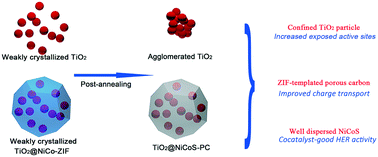High-performance TiO2 photocatalyst produced by the versatile functions of the tiny bimetallic MOF-derived NiCoS-porous carbon cocatalyst†
Abstract
Bimetallic zeolitic imidazolate framework (NiCo-ZIF)-templated NiCoS-porous carbon (PC) at only 0.2 at% exhibited versatile effects on the morphology as well as the photocatalytic hydrogen performance of TiO2 nanocrystals. It not only refined the TiO2 particle size during the post-annealing process at high temperature, but also transformed into a highly conductive NiCoS-PC cocatalyst. The conductive PC improved the transport of the charge carriers, and increased the numbers of exposed active sites by confining the particle size of TiO2. Furthermore, the well-dispersed NiCoS could be regarded as a hydrogen production cocatalyst on account of its improvement of the electrochemical hydrogen evolution reaction (HER). Consequently, the optimal TiO2–NiCoS-PC exhibited an extremely high photocatalytic hydrogen production rate of 1.29 mmol h−1 g−1, which is 64.5 and 2.4 times those of pristine TiO2 and commercial P25, respectively. This work provides an effective way of developing high-performance MOF-templated nanoporous photocatalysts.



 Please wait while we load your content...
Please wait while we load your content...